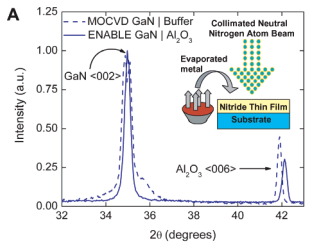Numerous technologies including solid-state lighting, displays, and traffic signals can benefit from efficient, color-selectable light sourcesthat are driven electrically. Semiconductor nanocrystals are attractive types of chromophores that combine size-controlled emission colorsand high emission efficiencies with excellent photostability and chemical flexibility. Applications of nanocrystals in light-emitting technologies,however, have been significantly hindered by difficulties in achieving direct electrical injection of carriers. Here we report the first successfuldemonstration of electroluminescence from an all-inorganic, nanocrystal-based architecture in which semiconductor nanocrystals are incorporatedinto a p−n junction formed from GaN injection layers. The critical step in the fabrication of these nanocrystal/GaN hybrid structures is the useof a novel deposition technique, energetic neutral atom beam lithography/epitaxy, that allows for the encapsulation of nanocrystals within aGaN matrix without adversely affecting either the nanocrystal integrity or its luminescence properties. We demonstrate electroluminescence(injection efficiencies of at least 1%) in both single- and two-color regimes using structures comprising either a single monolayer or a bilayerof nanocrystals.
Estimations indicate that as much as 20% of the world’selectricity is used for lighting.1,2 While the general lightingmarket continues to be dominated by incandescent andfluorescent systems, advantages such as reduced operatingexpenses, lower energy consumption, and more reliableperformance are the promises of solid-state lighting technologies.2 Current approaches to solid-state lighting havegenerally focused on combinations of phosphors and InGaNbased light-emitting diodes (LEDs).1 Since efficient InGaNLEDs typically produce light in the blue region of the opticalspectrum, a phosphor is required to perform color conversionto other desired wavelengths or to multiple wavelengths toproduce, e.g., white light. This strategy leads to significantenergy losses associated with below-unity conversion efficiencies of electrical power into optical output from theLED, relatively low efficiencies of light capture by thephosphor, nonradiative carrier losses during the re-emissionprocesses, and re-absorption of the “color-converted” photonsby the phosphor material. Considerable energy savings canbe achieved by approaches that directly incorporate color selectable chromophores into the LED structure, thus allowing direct excitation of the chromophores by electricalcurrent. In this configuration, the ultimate efficiency of adevice will be determined by two factors: the injectionefficiency of charges into chromophores and the probabilityof radiative recombination of the injected electron-hole (eh) pairs. In this paper we experimentally demonstrate thefeasibility of this approach using colloidal semiconductornanocrystals (NCs) as color selectable chromophores that aredirectly excited electrically using semiconducting GaNinjection layers.
The potential for NCs as the active media in light-emittingdevices and as viable alternatives to conventional phosphor emitters is apparent. NCs are unique in their abilityto offer size-tunable, narrow emission bands, high photoluminescence (PL) quantum yields (QYs) (>80%), andchemical flexibility3,4 without the drawbacks associatedwith other “soft-matter” emitters such as π-conjugatedmolecules that are characterized by broad emission spectraand poor stability with regards to photooxidation.5 However, an important concern related to light-emitting applications of NCs is the difficulty in achieving electricalpumping.
The most common approach to electrical injection ofcharges into NCs involves the use of hybrid polymer/NCdevices that demonstrate electroluminescence (EL) in boththe visible6,7 and near-infrared8,9 spectral ranges (using, e.g.,CdSe, InAs, and PbS NCs). In these cases, low carriermobilites in the organic components and poor conductionthrough the NC emissive regions lead to low deviceefficiencies. Recently, Coe et al.10 used a monolayer of NCssandwiched between hole- and electron-transport layers toavoid the problem of poor conduction through a thick NCactive region, thereby achieving an improvement in externalefficiencies.

Fig1
We report a new approach that avoids the use of organiccomponents and the low carrier mobilities associated withthese constituents and relies on a purely inorganic architecture to achieve direct charge injection into NCs. The chargeinjection structures reported here can be viewed as GaNp-i-n LEDs, in which the NCs form the intrinsic (i) layerthat is assembled onto a p-type GaN layer and overgrownwith n-type GaN. These inorganic devices are stable underambient atmospheric conditions.
Methods for combining NCs with semiconducting matrixmaterials have not been extensively pursued as a means ofachieving operation in the electrical injection regime. Themost recent and most successful attempt at NC overgrowthby a semiconducting material was demonstrated by Hannaand co-workers,11 who used metal-organic chemical vapordeposition (MOCVD) to deposit GaInP2 films on colloidalInP/GaInP2 core/shell NCs such that the crystallinity, shape,and PL characteristics of the NCs were retained. However,neither the transport properties of the composite nor the ELof the structure were reported. We have recently describedan optically pumped device consisting of an InGaN quantumwell overcoated with a monolayer of CdSe/ZnS core/shellNCs, in which energy-transfer pumping of the NCs by thequantum well with an efficiency of 55% was observed.12While experimental and theoretical evidence indicate thatNCs can be combined with an electrically driven quantumwell to achieve “noncontact” pumping of NCs via energytransfer, to realize such a device, engineering challenges,including the fabrication of thin, highly doped GaN topbarriers, must first be met. Our new p-i-n NC/GaNstructures reported here represent a novel, alternate strategyin which electrons and holes are delivered to NCs in themonolayer separately using n- and p-doped injection layersof GaN. Moreover, in contrast to the previous energy-transferdevices that were optically pumped, our p-i-n structuresalready show tunable light emission in the electrical injectionregime.